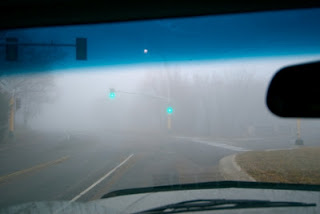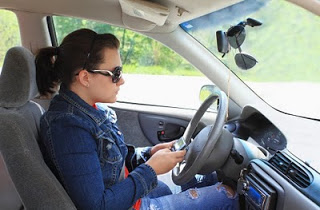Tag Archive: Teen drivers
Teen Driver Safety Devices
November 9, 2010
No matter what rules or boundaries a parent may set for their teen driver, once that teen is out of sight, the parent has to rely on trust and faith that the teen will obey those rules. However teens are teens and a multitude of outside influences can act on them to prevent their adherence to the rules. Fortunately, there are new technologies and driver safety devices available that can allow a parent to monitor their teen’s driving habits and whereabouts at all times.
Here are a few of the existing technologies that help give parents peace of mind:
Sprint’s Family Locator / Verizon’s Chaperone – http://sfl.sprintpcs.com/finder-sprint-family/welcome.htm / http://products.verizonwireless.com/index.aspx?id=fnd_chaperone, additional charges to monthly plan
Teens always have their cell phone with them and, if the teen is using a Sprint or Verizon phone, there are extra services available that allow a parent to track their teen’s location via a phone or computer. This allows a parent to monitor whether or not the teen is where he or she said they would be.
The Determinator Ignition Interlock Device – http://www.stopdwi.com/, $1,595 + shipping and installation fees
This breathalyzer interlock system will prevent the car from starting if the teen’s Blood Alcohol Level is above the legal limit. While expensive, this device guarantees that a teen can never drive drunk and that peace of mind may be well worth the investment..
DriveCam: Teen Safe Driver Program package – http://www.drivecam.com/, $899 plus monthly fees/FREE if insurance is covered by American Family’s auto insurance
This in-car camera system records “risky driving behavior”and sends them to DriveCam for third-party assessment of a teen driver’s skills. The reports are then sent to parents, who can discuss the driving behavior with their teen. Cars insured with American Family’s auto insurance may sign up for the Teen Safe Driver Program, which offers the device/service for free. American Family also claims that footage taken from a car will not be used as evidence and belongs to the purchaser.
CarChip Pro – http://www.carchip.com/Products/8226.asp, $119
CarChipPro is essentially a black box which, once the information is downloaded, provides parents with a history of the teen’s driving. The system may also be set to turn into an alarm if certain speeds are reached or if the driver is braking too hard. Like DriveCam, it is a tool to help discuss a teen’s driving habits by allowing parents to show them the facts, and how to correct their driving behavior.
MyKey – http://media.ford.com/article_display.cfm?article_id=29172, only available for Ford models manufactured in 2010
First seen on the 2010 Ford Focus, the MyKey system is designed to help parents set certain limitations on their Ford vehicles for when their teens are driving. With the configurable key, this system is designed for parents who share their cars with teen drivers.
The key features are:
- Speed Control, limiting the top speed of the Ford vehicle to 80 mph.
- Volume control, which allows parents to set a maximum volume level for the car’s radio.
- Beltminder, an alarm system that mutes the radio and plays a chime every 6 seconds, every minute or every 5 minutes when the seatbelt is unbuckled.
- Fuel reminder: alerts the teen that they need to refuel, when fuel is low.
No matter how good these technologies are, they still aren’t as effective as firm rules and boundaries set up by parents who provide a good driving role model for their child. Studies have shown that teens, whose parents have set clear boundaries and follow up with enforcement, have a safer driving record than those teens whose parents don’t set firm rules or who provide a poor role model for safe driving. Parents who want to start such a dialogue with their teens should consider a parent-teen contract before their child begins to drive on their own.

Tips for Teens: When is the Speed Limit too Fast for Conditions?
July 15, 2010
Many teens are so excited to get their driver’s licenses that much of the training they received prior to licensure is quickly forgotten. But it’s important for new drivers to follow the fundamental rules of the road, and adapting speed to conditions is one rule that’s frequently broken.
Driving too fast for conditions is considered speeding and can result in a traffic ticket. But that’s not the only reason to slow down – driving too fast for conditions is a contributing cause of many motor vehicle crashes. Motor vehicle crashes are the leading cause of death for 15- to 20-year-olds (based on 2005 figures, which are the latest mortality data currently available from the National Center for Health Statistics).
A 2009 analysis of speeding-related crashes by the National Highway Traffic Safety Administration (NHTSA) shows that following the speed limit is not enough to prevent a crash when conditions warrant a reduction in speed. The study showed that in speeding-related crashes that caused one or more injuries, 26% of the crashes were contributed to be exceeding the posted speed limit, while 74% were due to driving too fast for conditions. In property-damage-only crashes where speed was a contributing factor, 18% of the crashes were due to exceeding the posted speed limit and 82% of the crashes were contributed to by driving too fast for conditions.
Drivers should reduce their speed:
-immediately when it begins to rain. Roads become very slippery just after the rain begins, because the rainwater mixes with oil on the road that has been dropped from passing vehicles. Driving too fast on wet roads can result in skidding, when the vehicle loses traction with the road and the driver loses control of the vehicle.
-when roads are slippery due to snow or ice. Vehicles have even less traction on snowy or icy roads than they have in rainy weather. On icy roads, drivers should slow to a crawl and get off the road as soon as possible.
–in foggy or smoky conditions. Fog and smoke make it difficult to see ahead, and reducing speed reduces stopping distance.
-before a curve. Too often, drivers realize that they are moving too fast when they are already in the curve, but lowering speed in a curve results in a loss of traction that could cause a skid. Always reduce speed before entering the curve.
-in construction zones. Lower speed limits are usually posted in construction zones, but the new speed limit may not be low enough, especially for new drivers. The distraction of all the activity in the work zone and changes in the road surface can cause more difficulties for drivers who are inexperienced.
-around school zones and playgrounds. Again, lower speed limits are posted in school zones, but children are often present when the lowered limits are not in effect. Children are unpredictable and may walk, skate or bike into the road without checking for traffic.
-at night. Visibility is reduced at night; street lights and the vehicle’s headlights cannot entirely make up for this.
It’s also important to monitor your speed carefully on rural roadways with higher speed limits. Since the speed limit is already high, it’s easy to drive too fast for conditions, which often include curves, animals, farm equipment, and roads that are not well-maintained.
Pressure from teen passengers should also be considered. Passengers may encourage the driver to travel at or above the speed limit. Resisting this pressure is an important exercise in maturity for teen drivers and is an integral part of keeping their driver’s licenses. Unfortunately, it could even be a life-and-death matter.

Teens: Celebrate Your Graduation Safely
May 14, 2010
Graduation is finally here! Let me guess, you suddenly feel older, more mature, and ready for anything? You are on your way into the work force or heading off to college. Either way, freedom is within reach and it is time to celebrate! There are so many parties, dinners, and other events, all in you and your peers’ honor. Temptation will surround you. Peer pressure will be high, and the euphoria of the event will be a different pressure. You may think something like, “if I have one drink, it is not a big deal, I deserve to celebrate.” You may hear, “just have one drink, it won’t hurt you.” Before you give into the temptation, know the facts. It could save your life, a friend’s life, or a stranger’s life.
Did you know?
- 40, 000 people die every year in motor vehicle accidents
- 16,000 of those deaths are alcohol or drug related
- Graduation night is one night where impaired driving is most likely
- There is a zero tolerance law for impaired driving under the age of 20
What are possible consequences of impaired driving?
- Death of you, a friend, or stranger
- Serious injury of you, a friend, or stranger
- Loss of scholarships
- Incarceration
- Suspension or Revocation of your driver’s license
- Fines
Think about this before you drink/drug drive. You have a best friend that you have known since you were eight years old. You both are excited about the after graduation party. You drive you and your best friend to the party. You both decide to have a few drinks and you even take a hit off the joint being passed around. After all, it is your night and you have the right to celebrate. That is the last thing you remember and now you are waking up in the hospital. You are seriously injured, but far worse, you find out that your best friend was killed in a car accident on the way home from the party, and you are responsible. Situations like this have happened before and it CAN happen to you? Do you want to wake up in the hospital with serious injuries and someone telling you that you are responsible for the death of your best friend? I doubt it.
What can you do to keep yourself and others safe?
- Don’t drink or take drugs
- If you are impaired, call for a ride (taxi, sober friend or family member, ect.)
- Have a designated driver
- Do not get in a car with anyone who is impaired
- Sleep over
We can’t predict what others may do. So if you are riding with friends, have a plan if they become impaired. Know who you can call, be willing to ask for the keys, and if possible find out if they plan on drinking before going to the party with them. You may need to make alternate arrangements to get to the party.
It is an exciting time and you should celebrate your success. Your success can end in a matter of seconds with one bad decision. True freedom comes with smart decisions. Celebrate your entry into your adult life by making good decisions on your graduation night. Stay safe by staying sober.

Measures Taken to Stop Distracted Driving
May 5, 2010
Each day, as it seems, more and more information about the dangers of distracted driving comes out — which increases the awareness of drivers about the growing problem. But what has been done? What exactly are organizations and individuals doing to combat distracted driving?
Forming Organizations
When you Google “distracted driving groups” it will yield several results — of individuals banding together, increasing awareness on distracted driving, on a local or country-wide basis. These can be as simple as asking people to pledge against distracted driving, like Oprah’s No Phone Zone, or wearing thumb socks to show a driver’s support for not texting while driving. These groups establish their presence online, in various social networking services, making it easier for their targets to get the message.
Enacting Laws
With the nationwide awareness on the shocking statistics of texting while driving, local governments have acted to put in motion laws that would prohibit cell phone usage while on the road. So far, more than 30 states have a law that places a ban on texting while behind the wheel, urging drivers to think twice before they pull out their phones, unless they want a penalty. For now, the options are being weighed on how to effectively enforce texting ban laws — but public support usually wins, and a law is enacted.
Phone/Text-blocker apps
Stopping phone use while on the road? Simple. Install a phone/text-blocker app. These applications interface the phone to the car’s GPS and if it sees that the car is in motion, the app disables the phone’s features. With crash-risk increasing 4 times/talking on the phone and 23 times/texting — it may help discipline the driver into not relying on their phones so much while on the road, until hopefully, they won’t have a need for such an application anymore. Learn more about apps like this including http://www.Textecution.com/.
Mock Crashes
Several local/teen driving advocacy groups have set up mock crashes to remind teen drivers (the group who are most likely to engage in texting while driving) what could potentially happen if they text and drive at the same time. In most places, the mock crashes are set up in a way that, the first things that teens going to school are going to see are wrecked cars, teen-drivers-playing-dead-with-phone-in-hand and lots of fake blood. It is a shocking, yet accurate statement that would inform teen drivers of the potential consequences.
Trial Runs
There are also trial runs — usually hosted by a state’s DMV along with several advocates against distracted driving — they allow drivers to experience firsthand what could happen should they attempt to text while driving. Set in an enclosed space, with only traffic cones as obstacles, there are only a few who manage to get through the course without hitting any of the cones while texting/driving. There are drivers who believe they are perfectly capable of handling both tasks, but running through a trial distracted driving course more or less proves them otherwise.
Ads
Various organizations would release ads that are either funny or serious in order to make their point. Some organizations do their advertisements a step above by involving the people themselves — they create contests asking drivers if they have what it takes to get the message across, in video form. Which is a good thing — it awakens an enthusiasm and awareness in teen drivers — which makes them think about safety when driving.
Distracted Driving Courses
The addition of cell phones, texting and driving, in-vehicle video entertainment, and navigation systems lengthens the long list of driver distractions. Research reveals that many new drivers do not recognize the risk of these activities when driving. To make teen drivers more aware of the risks there are courses like Dangers of Distracted Driving. The course creates a clear understanding of the distractions while driving and how they can cause crashes and cost lives.

Motor Vehicle Crashes More Frequent For Teens with Own Cars
November 23, 2009
The journal Pediatrics recently published a study that showed that teens who report having their own vehicles (vehicles they don’t share with other family members) are more than twice as likely to have been involved in a recent motor vehicle crash. The study, a survey of 2,167 teens by researchers at Children’s Hospital of Philadelphia, indicated that teens who have their own vehicles are also much more likely to participate in other risky driving behaviors, such as using a cell phone and speeding.
Why might this be? According to driver safety experts, the following aspects of teens having vehicles for their sole use are potential contributors to the higher motor vehicle collision rate:
- The teen is more likely to have selected their own vehicle: Meaning a small, sporty car; high-powered, easily maneuverable vehicles tempt teens to drive faster and take more chances behind the wheel, such as weaving in and out of traffic.
- More driving time: When teens share a vehicle with other family members, they simply aren’t on the road as much. Teens who must return the vehicle by a certain hour so another family member can use it have a natural curfew that limits time on the road. While more driving time might make a teen driver more comfortable behind the wheel, she or he is not necessarily more skilled at driving. A false sense of confidence can lead teen drivers to take risks on the road.
- Extra freedom: When teens don’t have to request the keys, they quickly fall into the habit of driving whenever and wherever they want, and parents just as quickly get used to the freedom of not having to give rides to boisterous teens and their friends. This means that teens take more frequent trips, in addition to staying out longer.
- More passengers: Teens who don’t have to share their vehicles with their parents gain status amongst their friends because they can offer transportation to those who don’t have access to family vehicles. More time in the vehicle with teen passengers means trouble – teen passengers make driving much more risky for teen drivers.
Statistically, it’s safer for your teen to share a family vehicle rather than having one of their own. For parents who still intend to buy their teens their own vehicles, traffic safety professionals offer the following guidelines:
- Choose the vehicle carefully; research your options thoroughly. Teen drivers need stable, midsize vehicles with all the safety features you can afford. Frankly, if your teen is happy with your selection, it’s a sign that you may need to reevaluate your options and choose a different vehicle.
- Make sure your teen adheres to the Graduated Driver Licensing (GDL) laws in your state. If your state doesn’t impose time limitations for teen drivers, create your own as part of your house rules. Match the number of hours your teen is allowed to drive to the level of responsibility and maturity she or he exhibits.
- Don’t allow your teen to equate having her or his own vehicle to having unrestricted driving time. Set limits on the frequency and purpose for driving trips. Accompany your teen on trips in their vehicle occasionally and observe their driving behavior carefully, watching for any bad driving habits they may have picked up while driving alone.
- Use GDL laws and the number of safety belts in your car to determine the maximum number of passengers your teen is allowed to have in the vehicle.
Check frequently to make sure your teen is complying with your restrictions. Review your cell phone bill to ensure that your teen is not making calls when she or he is typically behind the wheel. Any deviation from the rules should result in restricted (or removed) driving privileges for a specified period of time. If teens aren’t following the ground rules for use of the vehicle, parents need to penalize them by taking the keys away and acting as chauffeurs for a time.
